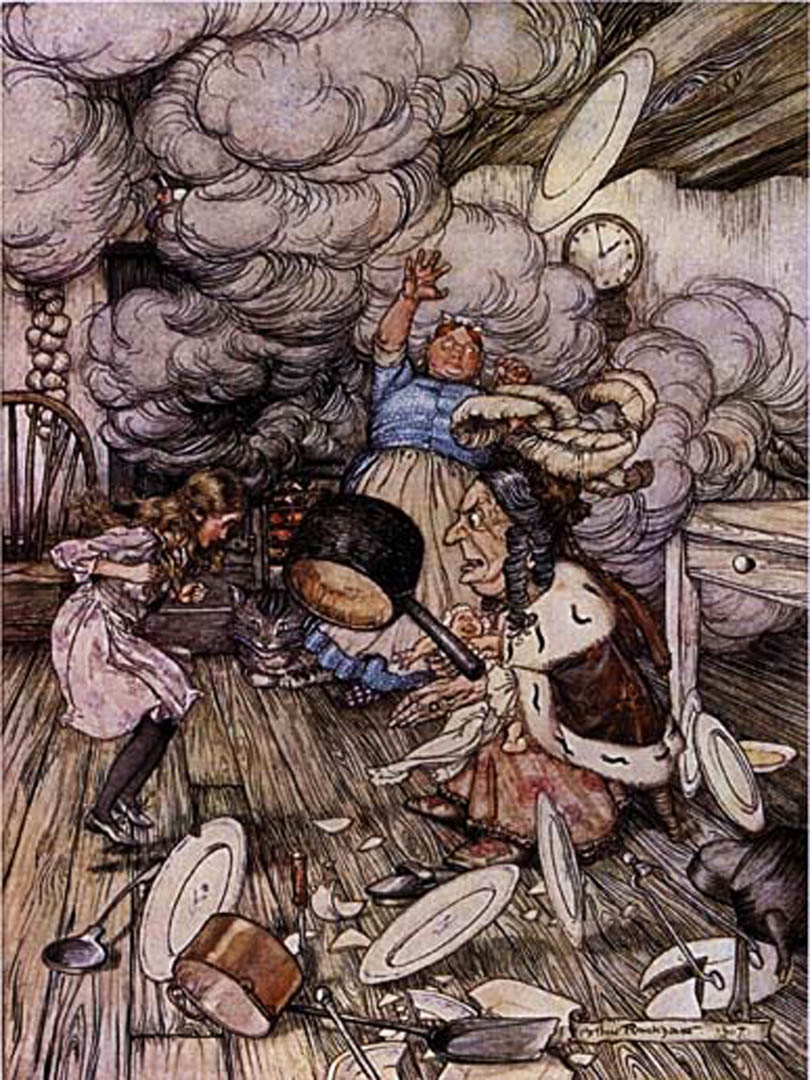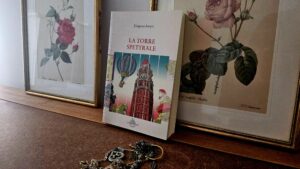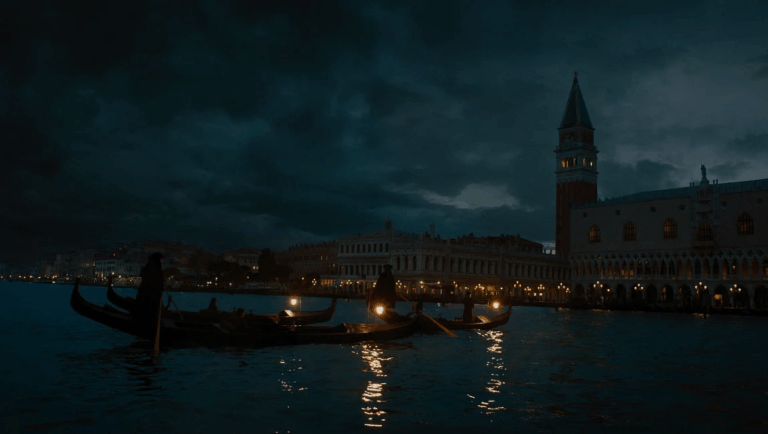Well, I haven’t done an Alice in Wonderland piece in a while and I’m sorry about that. As odd as it might sound, I’ve actually been on vacation and I cut on the non-work-related articles for a while. Now I’m back and I’d like to pick up where I left, with the Pig and Pepper chapter, which is chapter 6. We have already seen some illustrations from the beginning of the chapter, with the Frog and the Fish footman, and now it’s time to actually get inside the house. It’s one of the weirdest and most unsettling scenes of the whole book, I should warn you. And it features a pig dressed as a baby.
The door led right into a large kitchen, which was full of smoke from one end to the other: the Duchess was sitting on a three-legged stool in the middle, nursing a baby; the cook was leaning over the fire, stirring a large cauldron which seemed to be full of soup.
Up until now, we have very little information on the Duchess, but in Chapter 9 we’ll meet her again and we’ll know that Alice tries to keep her distance because the Duchess is «very ugly». This is why you’ll also find references to her character as «the Ugly Duchess». And most illustrators depict her as very ugly indeed, starting from Arthur Rackham who has a lot of fun in showing us the racket, and particularly the smoke, throughout the room.
But the tone is of course set best, when it comes to this kind of things, by John Tenniel (the first illustrator of Alice in Wonderland, a master when it comes to satire though Carrol didn’t like very much his way of drawing Alice). His Duchess is absolutely and utterly awful.
As you can see in the picture, this is also where we meet a particular grinning cat and the Duchess herself tells us that it grins like that because it’s a Cheshire-Cat. But it’s such a beloved character that we’ll give him (I can’t bring myself to refer to animals as “it”) his own article. For now, let’s see some more duchesses. I’m afraid they all are rather ugly.
The least ugly is without any doubt by Mabel Lucy Attwell, who could not resist making the Duchess pretty and round-faced like everything else in her sugary illustrations.
The second least ugly is probably this one, by Gordon Robinson, not to be confused with Charles or T.H. both illustrators we have already met. I found this picture for this auction and luckily enough also features a good shot of the edition: The Epworth Press in London. Giving the date (1919) it probably is one of the many editions that flooded the British book market as soon as royalties expired on the original work.
Through a search on this excellent resource, we can find him featuring on some issues of Little Folks, some fairy-tales and other story books.
Charles Robinson, on the other hand, gives us this close-up of the Duchess and her equally ugly kid. You’ve got to appreciate the china plates on the background, though, and their details.
There’s also another illustration that gets attributed to Gordon Robinson, but the style seems to be really really different and I couldn’t find any official source corroborating this idea.
One of the sources listing this as Robinson, however, is a good resource to see a couple more illustrations on the whole chapter and it’s this one.
Here we see a plate by wonderful Finnish author Tove Jansson, with delightful middle-age details for headdresses and what look like flamingoes on the Duchess’ mantle.
Another interesting one is by Mervyn Peake, an English writer, artist, poet, and illustrator who did some surrealist fiction known as the Gormenghast books. He worked on Alice during five golden years between 1943 and 1948, in which he also worked on S.T. Coleridge’s The Rime of the Ancient Mariner, the Brothers Grimm’s Household Tales, Quentin Crisp’s All This and Bevin Too and R.L. Stevenson’s Strange Case of Dr Jekyll and Mr Hyde.
He gives us a richly detailed Duchess, both for the pearls and the hair, with oddly worn-out gloves and tossing her baby in the air.
Another artist we have already met is Eric Kincaid: his blue-dressed dark-haired Alice is highly recognisable. You have to appreciate also the details in the dress and jewellery of the Duchess.
For some more contemporary artists, though as I was saying it’s a scene that often gets downplayed or overlooked, there’s something funny by Angel Dominguez, oval-framed. As you know, I like him a lot, both his Wonderland work and some of his illustrations for the Wind in the Willows. The red background fits very well both with the fiery contempt of the Duchess and the royal details of her attire.
Another good resource to find more works on this subject is this webpage, which features a good selection though doesn’t spend many words on the artists.
The first featured work is apparently attributed to Martha Hofrichter, born in 1872 in Brno. You can find her biography here alongside some incredible examples of her work. She worked on Alice in 1912.
A highly recognizable one on the same page is the one by our friend Will Pogany, from the 20s.
The Duchess has masculine traits and the cook has a lower class caricature look, but Alice as usual doesn’t seem that distressed. The cat, however, is having the time of his life.
Another old friend is Margaret Tarrant and, with her oval-framed illustrations she sometimes gives us, she focuses just on the Duchess “tending” to her kid, with everybody and everything else peeping from the corners of the picture: the cook with her cowl, the cat with his grin, a puzzled Alice with a red ribbon through her hair and what one might only assume it’s the pepper.




















No Comments